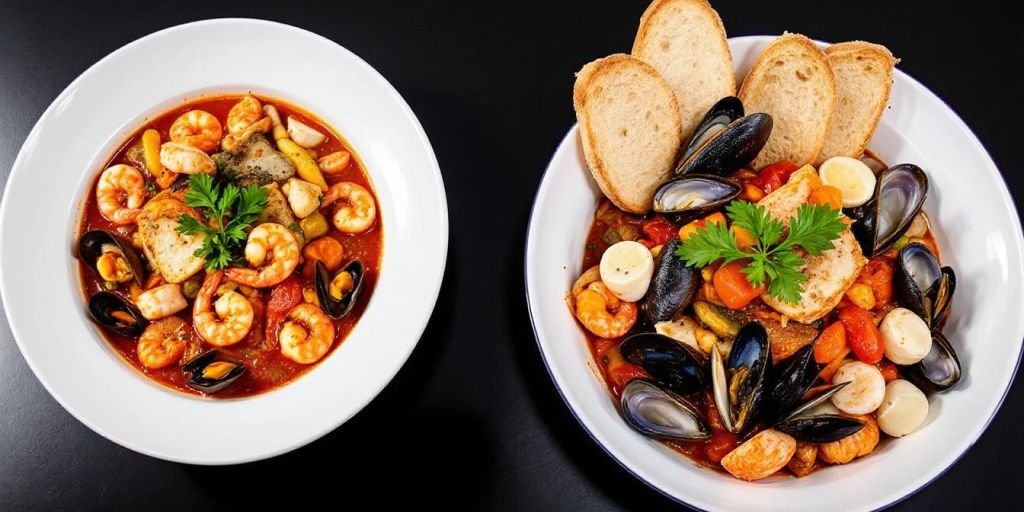
Cioppino and bouillabaisse are two delicious seafood stews that come from different cultures, each with its own unique history and flavors. While they may seem similar at first glance, there are key differences that set them apart. In this article, we will explore their origins, ingredients, cooking methods, taste profiles, and more, helping you understand what makes each dish special. By the end, you’ll be able to appreciate the distinct qualities of cioppino and bouillabaisse and decide which one you’d like to try!
Key Takeaways
- Cioppino is an Italian dish with a tomato-based broth, while bouillabaisse is a French stew made with fish broth.
- Bouillabaisse includes a special sauce called “rouille” that is spread on bread and adds extra flavor.
- The main spices used in each dish differ, giving them unique tastes and aromas.
- Both dishes are packed with seafood, but the types of fish and shellfish used can vary by region.
- Cioppino and bouillabaisse each have their own traditional accompaniments and serving styles.
Origins and History of Cioppino and Bouillabaisse
Italian Roots of Cioppino
Cioppino is a delicious seafood stew that has its roots in Italy. It is believed to have originated from the Italian fishermen in San Francisco during the 19th century. The dish was made from leftover fish and seafood, which were combined to create a hearty meal. The name “cioppino” likely comes from the Italian word “ciuppin,” meaning to chip in, as fishermen would contribute whatever they had to the pot. The history of cioppino is rich, with records suggesting it appeared during the Gold Rush days or as late as 1930, according to food historian Jean Anderson.
French Beginnings of Bouillabaisse
Bouillabaisse, on the other hand, hails from France, particularly the coastal city of Marseille. This traditional fish stew was originally made from the scraps of fish that fishermen could not sell. Over time, it evolved into a more refined dish, featuring a variety of fish and shellfish. The dish is known for its unique flavor, which comes from spices like saffron and fennel. Bouillabaisse is often served with a special sauce called “rouille,” which adds to its rich taste.
Cultural Influences on Both Dishes
Both cioppino and bouillabaisse reflect the cultural influences of their regions. Cioppino showcases the Italian love for fresh seafood and simple ingredients, while bouillabaisse highlights the French culinary tradition of using aromatic herbs and spices. These dishes not only represent their origins but also the culinary creativity of the people who made them popular.
Both cioppino and bouillabaisse are more than just meals; they are a celebration of the sea and the cultures that cherish it.
Key Ingredients in Cioppino and Bouillabaisse

Seafood Components
Both cioppino and bouillabaisse are packed with seafood, but the types of fish used can vary. Cioppino typically includes a variety of seafood such as:
- Dungeness crab
- Shrimp
- Scallops
- Clams
- Mussels
- Firm white fish like cod or halibut
In contrast, bouillabaisse often features:
- Scorpion fish (or substitutes like snapper)
- Shrimp
- Mussels
- Clams
- Other local fish varieties
Vegetable Additions
Vegetables play a crucial role in both dishes. In cioppino, you will find:
- Onions
- Garlic
- Fennel
- Tomatoes
Bouillabaisse, on the other hand, includes:
- Potatoes
- Fennel
- Tomatoes
- Orange peel for a unique twist
Unique Spices and Herbs
The spices and herbs used in these dishes also set them apart. Cioppino is often seasoned with:
- Basil
- Parsley
- Red pepper flakes
While bouillabaisse is known for:
- Saffron
- Fennel seeds
- Orange zest
Both dishes showcase the rich flavors of the sea, but their unique ingredients create distinct culinary experiences.
| Ingredient Type | Cioppino | Bouillabaisse |
|---|---|---|
| Seafood | Crab, shrimp, scallops, clams | Scorpion fish, shrimp, mussels |
| Vegetables | Onions, garlic, fennel, tomatoes | Potatoes, fennel, orange peel |
| Spices | Basil, parsley, red pepper flakes | Saffron, fennel seeds, orange zest |
Cooking Techniques for Cioppino and Bouillabaisse

Preparation Steps for Cioppino
To make a delicious cioppino, follow these steps:
- Gather your seafood: Use a mix of fresh fish, shrimp, and shellfish. Common choices include crab, clams, and mussels.
- Prepare the base: Start with a base of sautéed onions and garlic in olive oil. Add chopped tomatoes and let them cook down.
- Add the seafood: Once the base is ready, add your seafood and let it simmer until everything is cooked through.
Bouillabaisse Cooking Process
Bouillabaisse has its own unique steps:
- Make the broth: Begin by simmering fish bones, shrimp shells, and water to create a rich fish stock.
- Sauté vegetables: In a separate pot, sauté onions, leeks, and fennel until soft.
- Combine and simmer: Add the broth to the vegetables, then introduce your fish and shellfish. Let it cook until the seafood is tender.
Common Mistakes to Avoid
When cooking these dishes, keep these tips in mind:
- Don’t overcook the seafood: This can make it tough and chewy.
- Use fresh ingredients: Fresh seafood makes a big difference in flavor.
- Balance the flavors: Adjust spices and herbs to ensure a well-rounded taste.
Cooking cioppino and bouillabaisse can be a fun experience. Remember, the key is to enjoy the process and share the meal with others!
Flavor Profiles of Cioppino and Bouillabaisse
Cioppino’s Tomato-Based Broth
Cioppino is known for its rich tomato broth, which gives it a hearty and satisfying flavor. The base is made from stewed tomatoes, garlic, onions, and a splash of red wine. This combination creates a savory and slightly sweet taste that pairs well with various seafood. Common seafood ingredients include:
- Dungeness crab
- Shrimp
- Scallops
- Clams
- Mussels
Bouillabaisse’s Fish Stock Base
In contrast, bouillabaisse features a delicate fish stock base. This broth is often flavored with saffron, orange zest, and fennel seeds, giving it a unique and aromatic profile. The addition of a rouille sauce, made from garlic, olive oil, and spices, enhances the dish’s flavor. Key ingredients typically include:
- White fish (like snapper or sea bass)
- Shrimp
- Mussels
- Potatoes
Impact of Spices on Flavor
The spices used in each dish play a crucial role in defining their flavors. Here’s a quick comparison:
| Flavor Component | Cioppino | Bouillabaisse |
|---|---|---|
| Base | Tomato broth | Fish stock |
| Key Spices | Basil, oregano, thyme | Saffron, orange zest, fennel |
| Sauce | None | Rouille |
Both cioppino and bouillabaisse offer unique flavors that reflect their cultural origins. While cioppino is heartier and tomato-based, bouillabaisse is lighter and fish-based, showcasing the best of Italian and French culinary traditions.
Nutritional Comparison of Cioppino and Bouillabaisse

Caloric Content
When comparing the caloric content of cioppino and bouillabaisse, cioppino tends to be higher in calories due to its rich tomato base and the variety of seafood used. Here’s a quick look at the average calories per serving:
| Dish | Calories per Serving |
|---|---|
| Cioppino | 350 |
| Bouillabaisse | 250 |
Protein and Vitamin Levels
Cioppino is known for its higher protein content because it includes a larger variety of seafood. Here’s a breakdown of the protein levels:
- Cioppino: Approximately 30g of protein per serving
- Bouillabaisse: Approximately 20g of protein per serving
Both dishes are rich in vitamins, especially vitamin C from the tomatoes in cioppino and various vitamins from the fish in bouillabaisse.
Health Benefits of Each Dish
Both cioppino and bouillabaisse offer health benefits, including:
- High in omega-3 fatty acids from seafood
- Rich in antioxidants from tomatoes and herbs
- Low in saturated fats, making them heart-healthy options
Both cioppino and bouillabaisse are not just delicious but also provide a nutritious meal option, making them great choices for seafood lovers.
Serving Suggestions for Cioppino and Bouillabaisse
Traditional Accompaniments
- Crusty bread is a must for both dishes, perfect for soaking up the delicious broth.
- A side of rouille sauce enhances the flavor of bouillabaisse, adding a creamy texture.
- Fresh herbs like parsley or basil can brighten up the presentation and taste.
Wine Pairings
- Cioppino: A light white wine, such as Pinot Grigio, complements the tomato base.
- Bouillabaisse: A full-bodied white wine like Chardonnay pairs well with the rich fish stock.
- For both dishes, a chilled rosé can be a refreshing choice.
Presentation Tips
- Serve in deep bowls to showcase the colorful seafood and broth.
- Garnish with fresh herbs for a pop of color.
- Consider using a seafood platter for a more elegant presentation.
Both cioppino and bouillabaisse are not just meals; they are experiences meant to be shared with family and friends. Enjoying these dishes together can create lasting memories.
Regional Variations of Cioppino and Bouillabaisse
West Coast Cioppino
Cioppino is especially popular on the West Coast of the United States, particularly in San Francisco. This version often includes local seafood like Dungeness crab, which is a staple in the area. The dish is typically served with sourdough bread, making it a comforting meal for many.
Provencal Bouillabaisse
Originating from the coastal region of Provence in France, bouillabaisse is known for its rich flavors and unique ingredients. The traditional recipe requires specific fish, such as scorpion fish, which is hard to find outside of France. Saffron is a key spice that gives this dish its distinct taste and color.
Modern Twists on Traditional Recipes
Today, chefs are experimenting with both cioppino and bouillabaisse, adding new ingredients and flavors. Some modern variations include:
- Using different types of fish and shellfish.
- Incorporating local vegetables for added freshness.
- Experimenting with spices beyond the traditional recipes.
Both cioppino and bouillabaisse reflect the cultural diversity of their regions, showcasing local seafood and flavors.
In summary, while cioppino and bouillabaisse share similarities, their regional variations highlight the unique ingredients and cooking styles of their respective areas. The seafood that goes into cioppino generally has a regional focus, integrating ingredients like Dungeness crab in San Francisco or lobster in Maine.
Cioppino and bouillabaisse are two delicious seafood stews that vary by region. Each area adds its own twist, making these dishes unique. If you want to learn more about these tasty variations and discover recipes, visit our website!
Final Thoughts on Cioppino and Bouillabaisse
In conclusion, cioppino and bouillabaisse are both delicious seafood stews that come from different cultures. Bouillabaisse, with its fish broth and special rouille sauce, has a French flair, while cioppino, made with a rich tomato base, showcases Italian roots. The main differences lie in their ingredients, flavors, and origins. Bouillabaisse often uses saffron and orange zest, while cioppino includes more tomatoes and a variety of seafood. Whether you prefer the comforting warmth of cioppino or the aromatic spices of bouillabaisse, both dishes offer a unique taste of their heritage. So, next time you’re in the mood for seafood, consider trying one of these delightful stews!

Frequently Asked Questions
What is the main difference between cioppino and bouillabaisse?
The biggest difference is their base. Cioppino uses a tomato broth, while bouillabaisse is made with a fish broth.
Where did cioppino originate?
Cioppino comes from Italy, especially from San Francisco, where Italian fishermen created it.
What are the key ingredients in bouillabaisse?
Bouillabaisse includes fish, shrimp, mussels, and spices like saffron and orange peel.
Can I use frozen seafood for these dishes?
Yes, frozen seafood works well for both cioppino and bouillabaisse and can taste just as good.
What is rouille sauce?
Rouille is a sauce that often comes with bouillabaisse, made from garlic, olive oil, and sometimes egg.
Are cioppino and bouillabaisse healthy?
Both dishes are nutritious, packed with seafood and vegetables, making them a healthy choice.



